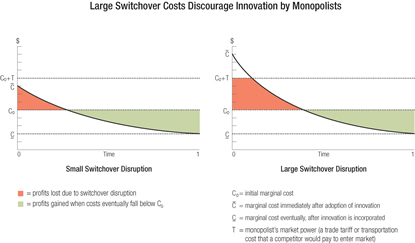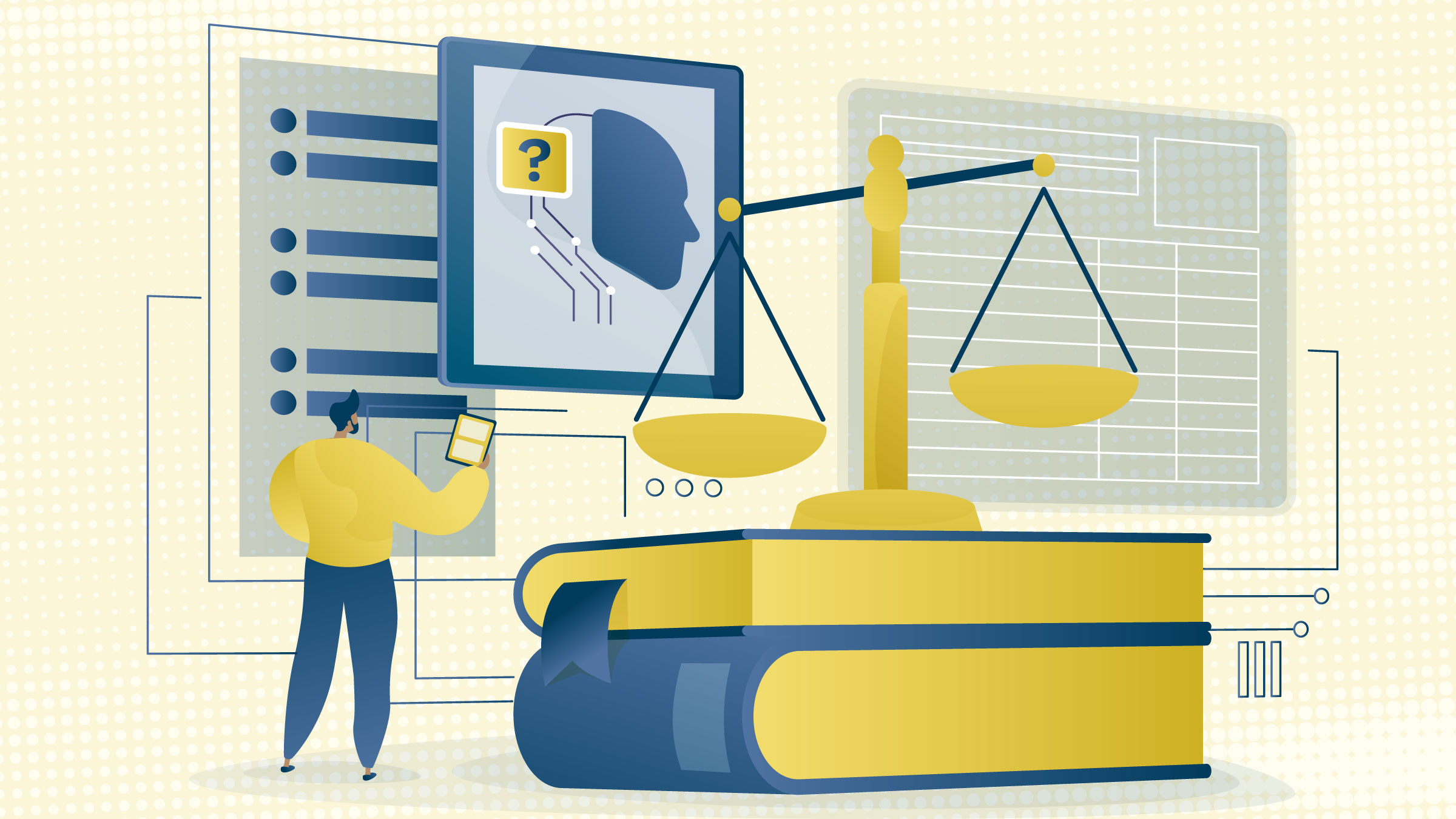Over the past decade, a steady flow of research has shown a strong real-world relationship between competitive markets, technological innovation and higher productivity. This work argues powerfully that if nations wish to grow economically, they should eliminate obstacles to competition—whether from trade barriers, patents or other forms of anticompetitive practice.
But the theoretical case for this relationship is far weaker than the empirical evidence. Indeed, standard theory is ambiguous as to whether a competitive or monopolistic environment is more likely to be innovative and productive. Some schools of thought suggest that monopolies have less incentive to innovate; others argue that competition is less favorable to the spread of innovation.
In a recent Minneapolis Fed staff report, three economists suggest that standard theory—of both schools—has been built on a flawed assumption; when that assumption is corrected, they argue, theory aligns with data in finding that competition is more conducive than monopoly to innovation and productivity.
The flawed assumption? That adopting a new innovation is a smooth, problem-free process. The correction: Technological innovation is subject to “switchover disruptions,” those troublesome glitches or outright disasters that accompany virtually every change in procedure or process. Think of when you switched your cell phone company. Expand that to a corporatewide adoption of a new process, and the potential for disruption becomes obvious. When this disruption is taken into account, standard theory is brought into line with real-world experience: Monopolies are less likely to innovate.

David Levine, Tom Holmes and and Jim Schmitz in Cambridge, Mass., in July,
just before presenting their paper at an NBER workshop.
“If firms face switchover disruptions, then they may temporarily lose some unit sales upon adoption,” write Thomas Holmes, David Levine and James Schmitz in “Monopoly and the Incentive to Innovate When Adoption Involves Switchover Disruptions,” a Minneapolis Fed staff report and National Bureau of Economic Research working paper. “Greater market power will mean higher prices on those lost units of output, and hence a reduced incentive to innovate.”
The concept is fairly straightforward. Change isn't easy, and because monopolists make higher profits than competitors, their opportunity cost of change is higher as well. As Levine put it in an e-mail, "Monopolists tend to be more conservative in innovating because they have more to lose."
The Austrian school
Straightforward? Perhaps. But some of the field's brightest minds have viewed this quite differently. Austrian economist Joseph Schumpeter, a prominent Harvard scholar, was the first theoretician to devote substantial attention to innovation. He considered it a crucial step in the process of what he termed “creative destruction,” in which new firms incessantly overtake the old as capitalist economies evolve.
Monopolies didn't really worry Schumpeter. Indeed, he thought most economists held competition on too high a pedestal. “Perfect competition is not only impossible but inferior, and has no title to being set up as a model of ideal efficiency,” he wrote in his 1942 classic, Capitalism, Socialism and Democracy. “Most of the facts and arguments … tend to dim the halo that once surrounded perfect competition as much as they suggest a more favorable view of its alternative.”
According to Schumpeter, monopolies and innovation are closely related. As French economist Jean Tirole points out in The Theory of Industrial Organization, Schumpeter argued “that monopolies are natural breeding grounds for R&D and that if one wants to induce firms to undertake R&D one must accept the creation of monopolies as a necessary evil.” Schumpeter was vague about whether monopolies per se or simply big firms are more conducive to R&D than small competitive firms, but he did suggest several reasons large establishments are “better-qualified or more eager to undertake R&D than smaller firms," according to Tirole: They can take advantage of increasing returns prevalent in R&D, they have greater capacity to take on the inherent risk, their large production facilities ease implementation of innovations and "a monopolist does not have competitors ready to imitate his innovation.”
Arrow's point
Schumpeter's theories were controversial on several fronts, and even as economists came to accept his ideas about the importance of entrepreneurs and innovation, many would continue to argue that monopolies squelched rather than nurtured innovation. Stanford's Kenneth Arrow was the first to offer a rigorous mathematical treatment of the issue, and his seminal 1962 article, “Economic Welfare and the Allocation of Resources for Invention,” drew a conclusion directly at odds with Schumpeter. “The incentive to invent,” wrote Arrow, “is less under monopolistic than under competitive conditions.”
Arrow set down simple equations for unit costs of production before and after an invention, and the corresponding prices, quantities, inventor royalties and monopolist profits. He assumed a downward-sloping demand curve, so that a higher product price would result in a lower quantity demanded by consumers (price elasticity). And he assumed that only the monopolist could adopt a cost-saving innovation; that is, the incumbent firm wouldn't have to worry about a potential rival buying this new technology and entering the market. (Of course, for some innovations, rivalry isn't an issue. A monopolist might simply consider adopting a new supply system, not a new physical invention.)
In this situation, Arrow showed, a monopolist would have a lower incentive to adopt innovation because monopolies maximize profit by raising price and reducing quantity supplied compared with competitive markets. A monopolist would therefore have relatively few units of output over which to spread the fixed cost of the new technology.
Arrow's argument, later termed “the replacement effect,” was convincing. A firm in a competitive market would have high output levels, and so the cost of an innovation could be spread thinly, but a monopolist, with lower output, would be less inclined to incur that additional cost. That isn't to say a monopolist would never innovate, simply that its motivation would always be lower than that of a firm in a competitive environment. “The preinvention monopoly power acts as a strong disincentive to further innovation,” Arrow concluded.
(Another way to look at it: A firm with a weak monopoly position because of low tariff protection against foreign competition is going to produce more output than a firm enjoying higher tariff protection; the latter will have less incentive to innovate because—again—it has less output to “justify” the fixed cost.)
On the other hand
In 1982, University of California, Berkeley, economist Richard Gilbert and David Newbery of Cambridge University presented a counterargument. Arrow, they wrote, had “assumed that entry was blockaded” by the monopolist—that is, for the sake of argument he presupposed that only the incumbent firm could choose whether or not to adopt an innovation.
But in reality, innovations are often available to both incumbents and rivals in any particular market. Inventors create, and firms can vie for that creation. Both Microsoft and Yahoo, for instance, could have owned YouTube, but Google bought it. And if a potential rival might adopt an innovation that would put an incumbent monopolist at a competitive disadvantage, that implies a very different incentive structure than Arrow imagined.
The Gilbert-Newbery model, then, says that a monopolist must choose between adopting an innovation and allowing a rival to adopt it. The monopoly firm must calculate not only the value of the innovation to its own operation, but the repercussions of allowing a rival to have it. In this situation, the economists showed, monopolists often have a strong incentive to innovate, if only to preempt their rivals.
“Under certain conditions,” Gilbert and Newbery wrote, “a firm with monopoly power has an incentive to maintain its monopoly power by patenting new technologies before potential competitors. … The monopolist will preempt if the cost is less than the profits gained by preventing entry.”
Monopolists, they pointed out, might never implement the new technology, but in the long run this “patent shelving” isn't necessarily harmful. "Preemption need not have adverse consequences for economic welfare. Preemption requires investment in product development with only a probability of successful entry deterrence. Society gains from the development of new technology at a pace at least as rapid as would occur with more competition."
The Gilbert-Newbery analysis—sometimes called the “efficiency effect”—led economists to a more favorable view of monopoly and innovation, closer to that envisioned by Schumpeter. And indeed, they reference the Austrian. “Since entry at some date is inevitable, to the extent that preemption does occur it is a phase in the Schumpeterian process of creative destruction.”
Disruption
So, we're back where we started: Theory on the relationship between monopoly and innovation remains unclear. Schumpeter believed that innovation required a significant measure of monopoly. Arrow demonstrated the reverse—that monopolists are less likely to innovate. Gilbert-Newbery showed the opposite could be true.
For empirical economists, this messy theoretical debate has produced more smoke than fire, but over the past decade, their research has nonetheless found—in a wide variety of contexts—that more competition tends to result in increased innovation and higher productivity (see sidebar below). Still, without solid theory to explain the data, economists feel ill at ease.
More Competition = More ProductivityResearchers have found a widespread pattern of freer markets and greater efficiency Over the past eight years, economists have developed a significant body of research establishing empirical links between increased competition and higher productivity. Jim Schmitz, with Tom Holmes and other colleagues, has been behind several of these studies. In 2001, Holmes and Schmitz found that the U.S. shipping industry, characterized by substantial monopoly power among water transport firms during the 19th and 20th centuries, became much more efficient when railroads, and later trucks, provided competition. In 2002 and 2005, Schmitz, with José Galdon-Sanchez, established that increased competition in the iron ore industry led firms to adopt new technologies (a change in work rules) that resulted in a productivity surge. In 2008, Schmitz, with Timothy Dunne and Shawn Klimek, found that when the U.S. cement industry faced increasing competition from foreign producers, it adopted new work rules and increased productivity. Other researchers have made similar connections. In 2004, economist Daniel Trefler found that labor productivity rose significantly when the Canada–United States Free Trade Agreement eliminated trade tariffs between the nations and thereby increased competition among manufacturers on both sides of the border. Chad Syverson’s 2004 research on the U.S. ready-mixed concrete industry found that firms in geographic areas with many competitors were more productive than those with little competition. In 2007, looking at the electric power industry in the United States, Kira Fabrizio, Nancy Rose and Catherine Wolfram showed that replacing regulated monopolies with a more market-based structure resulted in modest efficiency benefits. And in 2008, when George Symeonidis examined the impact of anticartel laws introduced in the United Kingdom in the late 1950s, he discovered that cartels had had a significant negative impact on labor productivity. —Douglas Clement |
Finding the link in theory that exists in fact required a flash of inspiration—a disruptive innovation, if you will—for Minneapolis Fed visiting scholar Tom Holmes of the University of Minnesota, David Levine of Washington University, and Minneapolis Fed senior economist Jim Schmitz. Interviewed together at the Minneapolis Fed, Holmes and Schmitz recalled that the genesis of their collaboration with Levine on this project was the mutual need to bring theory into line with reality.
“It's been like a folk idea, the notion that monopoly is less efficient,” observes Holmes, “but when we sit down and write our models, we haven't been able to get it to go that way. Yes, there's an empirical link between competition and productivity, but the theory has been tough. Why wouldn't a monopolist be just as efficient as a competitor? Why would they leave money on the table? Just to try to understand that has been a bit of a trick.”
“I like to think it went back to my iron ore paper,” says Schmitz, referring to a seminar he gave in the fall of 2002 at the University of California, Los Angeles, where Levine taught for many years. Schmitz's research found that iron ore producers in countries faced with tough international competition exhibited increased productivity, while those facing little competition showed no increase in productivity.
“David saw my presentation at UCLA,” says Schmitz, “and later he would send e-mails about what might be going on to explain why, when competition came, we saw productivity gains in the iron mines.”
“This is pretty hard to understand,” observes Holmes who has collaborated frequently with Schmitz, but never before with Levine. “And David wanted to understand it. He's a brilliant theorist—really one of the top theorists, bar none, in the entire world—and he's trying to figure out, why is that? Why is that?”
“The question of why monopolies are so stagnant has puzzled me for a very long time,” says Levine, via e-mail. “Jim's iron ore research was instrumental in that he had a very clear micro-level examination of how this happens in practice.”
Initially, Schmitz and Levine corresponded about the problem; then Holmes joined the discussions during Levine's visits to the Minneapolis Fed. (Levine was a consultant at the Bank in 2004-05; his work on intellectual property was the focus of a September 2002 Region article.)
Jim and I talked about the whys quite a bit, recalls Levine. “Tom has also been interested in these issues for a long time; he's collaborated with Jim, and I've known him and admired his work for an equally long time. I think at some point when I was visiting at the Bank the three of us started talking more about it, and the paper grew out of those ideas.”
The innovation
Like many powerful concepts, the idea behind their paper is quite simple: Innovation is disruptive, and disruption is more costly to a monopolist than to a competitive firm. Schumpeter, Arrow, and Gilbert and Newbery all had implicitly assumed that adoption of innovation is a seamless, trouble-free process. And that assumption hardly jibes with the world as we know it.
Consider Boeing. Standard practice for the airplane manufacturer had long been for all outside suppliers to ship parts to company facilities in Everett, Wash., and do virtually all assembly on site. To produce its highly anticipated 787 Dreamliners, however, the company initiated a new production plan under which suppliers would preassemble large sections of the plane and Boeing would perform only the final stages of assembly. Major gains in efficiency were anticipated.
But suppliers were unable to stay on schedule, and eventually Boeing reversed itself, calling on suppliers to ship unassembled work to Everett. That plan also went awry. "Boeing has ended up with a pile of parts and wires, and lots of questions about how they all fit together," reported the New York Times in January this year, “not unlike a frustrating Christmas morning at home.” Airlines had ordered 817 of the planes, worth more than $100 billion, and delivery had been scheduled for late 2008. With the switchover disruption, Boeing says it hopes to start making deliveries in 2009.
Regardless of when the planes actually arrive, Boeing is—for a significant period of time—losing money. “The sales are being pushed to the future,” notes Schmitz. “Boeing could have sold these planes earlier if they'd stuck to the old technology. But because they innovated, sales are delayed, and that's a substantial loss.”
Newspaper headlines and daily life provide an ongoing series of plans that don't work out when institutions change their standard operating procedure, when corporations innovate and the innovations fail. New Coke, anyone?
The economists cite switchover disruptions in General Motors car manufacturing robotics, Denver airport's baggage-handling system, Japanese steel makers shifting from open-hearth to basic-oxygen furnaces, work rule changes, new workplace compensation schemes. “And, of course,” they write, “introducing new information technology systems often leads to significant disruptions.”
The model
Since disruption is an empirical reality when innovations are adopted, models hoping to illuminate the process should account for disruption. So in their paper, Holmes, Levine and Schmitz take the standard models used by economists to understand innovation and monopoly—Arrow and Gilbert-Newbery—and introduce disruption.
They begin with the Arrow model. The standard setup assumes elastic demand, and Arrow's classic result of monopolies having less incentive to innovate hinges on this assumption. But when Holmes, Levine and Schmitz introduce switchover disruption into the Arrow model, they find that Arrow's elasticity assumption is no longer necessary.
“If demand is perfectly inelastic, the Arrow effect goes away. No difference between competition and monopoly,” observes Holmes. “Put that elastic demand in, and of course you get [the Arrow effect]. But we found that even if you strip out the thing that Arrow's model focused on, putting in switchover disruption gets back the inverse relationship between monopoly and incentive to innovate.”
The Arrow model is the easier case; the economists' paper deals at greater length with Gilbert-Newbery. But to give the Gilbert-Newbery argument (the efficiency effect) its full power, the economists strip out Arrow's replacement effect by assuming inelastic demand: Quantity demanded isn't affected by changing prices, so monopolists won't necessarily have fewer units over which to spread the cost of innovation.
They set up their mathematical model so that an incumbent and a rival firm can bid for an innovation. Their object is to determine-first without switchover disruption and then with-how willingness to pay for innovation varies with degree of monopoly power. Without switchover disruption, their model replicates the Gilbert-Newbery result. “Innovation is worth more to the incumbent than a new entrant and so the incumbent will preemptively patent before a rival,” they write. “The incumbent will take into account that if it does not preemptively innovate and the entrant adopts instead, the incumbent will lose its monopoly rent. In contrast, the rivals have no rent to forgo if they don't innovate.”
Then, for five pages of mathematical propositions and proofs (plus a short appendix devoted to proving a lemma), the paper examines the Gilbert-Newbery model, with switchover disruption. The authors derive the incumbent's return (or profit) if it acquires and adopts the innovation, the incumbent's return if it acquires but idles the innovation, the incumbent's return if it doesn't acquire (so the rival gets it) and the rival's return if it acquires and adopts. And then they determine willingness to pay for innovation in the face of switchover disruption.
In the end, they find that large disruptions overturn Gilbert-Newbery. That is, that “with 'enough' switchover disruption, increases in market power now lead to decreases in industry innovation.” If disruptions are minor—if the road bumps toward more efficient production are small—then Gilbert and Newbery's finding still holds. But if change is difficult and costly—truly disruptive—monopolies have a large incentive not to change. After all, they'll be sacrificing monopoly rents for as long as disruption ensues.
In two simple graphs (shown below), they represent the finding symbolically.

The second graph shows the large-disruption story. Adopting the new technology is so difficult that marginal costs of production soar well above not only the original marginal cost but also the original marginal cost plus the monopolist's market power, represented by T (representing a trade tariff, perhaps, or transportation costs). A firm facing this kind of disruption weighs the relative sizes of the two areas-before and after costs drop below the original marginal cost-and finds the initial losses so daunting that it will be unlikely to innovate.
"To the extent you think switchover costs are important, it's not ambiguous," notes Holmes. "If you set the problem up like Arrow did or if you set the problem up like Gilbert and Newbery did, once you throw in switchover costs, it goes only one way. And the economics are pretty clean, right? It's just that it's costly to give up monopoly rents. Adoption involves some sort of sacrifice."
The elusive link
This then may be the link between theory and reality, the elusive explanation for higher productivity that appears to be unleashed when competition undermines monopoly power. Providing that link is crucial to understanding how the structure of an economy can affect its prospects for growth, and for all three economists, this is incentive for further research.
“It's a powerful idea and brings to mind other possible examples,” notes Schmitz. “Like CEOs. Do you replace a CEO or not? You can have switchover disruptions.” As an empiricist, Schmitz is envisioning future applications. “It makes me think about data and where to look. I've done this work on iron ore and cement, and it seems this is a more general idea. It opens up new avenues for empirical work.”
The new avenues will mesh with previous collaborations. “There's the tariff paper we wrote a while back,” says Holmes, referring to a 1995 Quarterly Review article with a model in which competition via trade reduced resistance to new technology. “And then our railroad paper [a 2001 QR] and then a Journal of Monetary Economics paper [in April 2001]. This is a different angle on all that.”
And as Levine points out, all of this research is not simply academic deliberation. Clarifying the relationship between industry structure and productivity has strong policy implications. “Empirically, it is well understood that monopoly is inimical to innovation,” he says. “Understanding why is key to public policies that lead to greater innovation. For example: Should we engage in antitrust? Or remove impediments to foreign competition? Will this lead to greater rates of technological progress?”
“This,” concludes Holmes, “is just one piece of a long-running research program looking at the connection between productivity and competition.”
Stay tuned.
Related papers: Monopoly and the Incentive to Innovate When Adoption Involves Switchover Disruptions
Resistance to New Technology and Trade Between Areas





